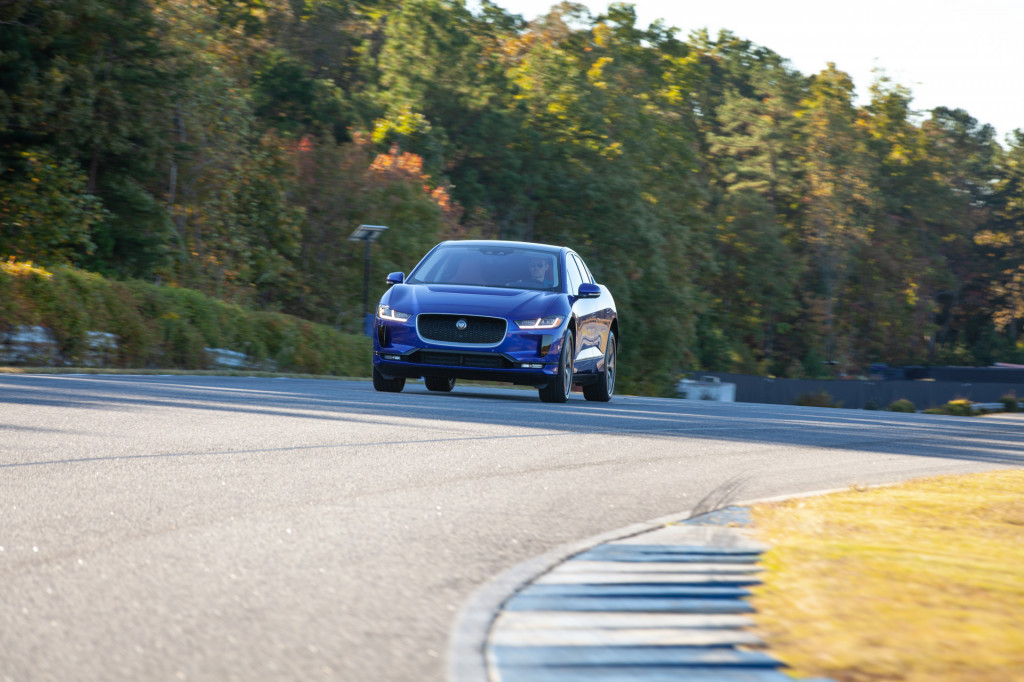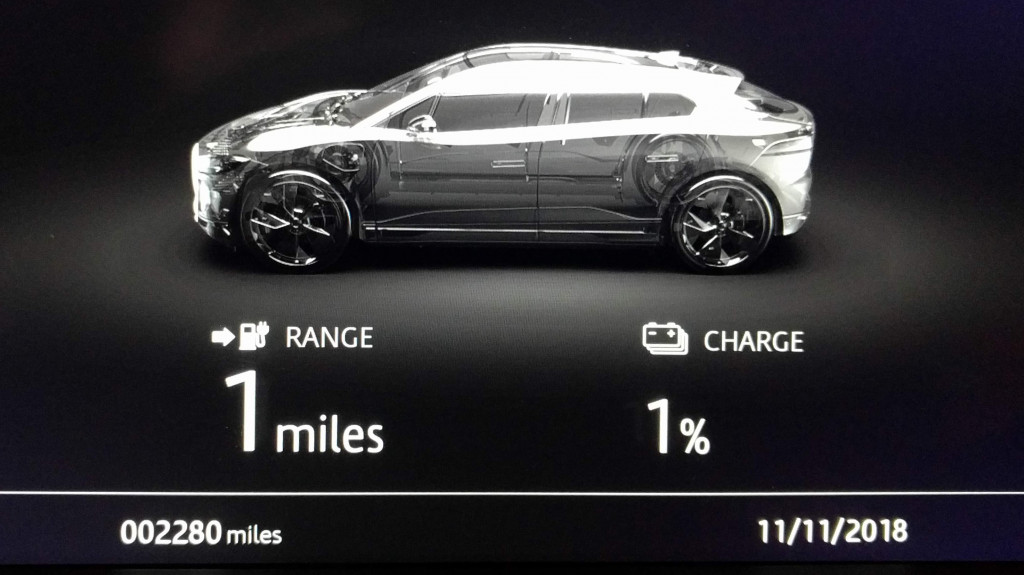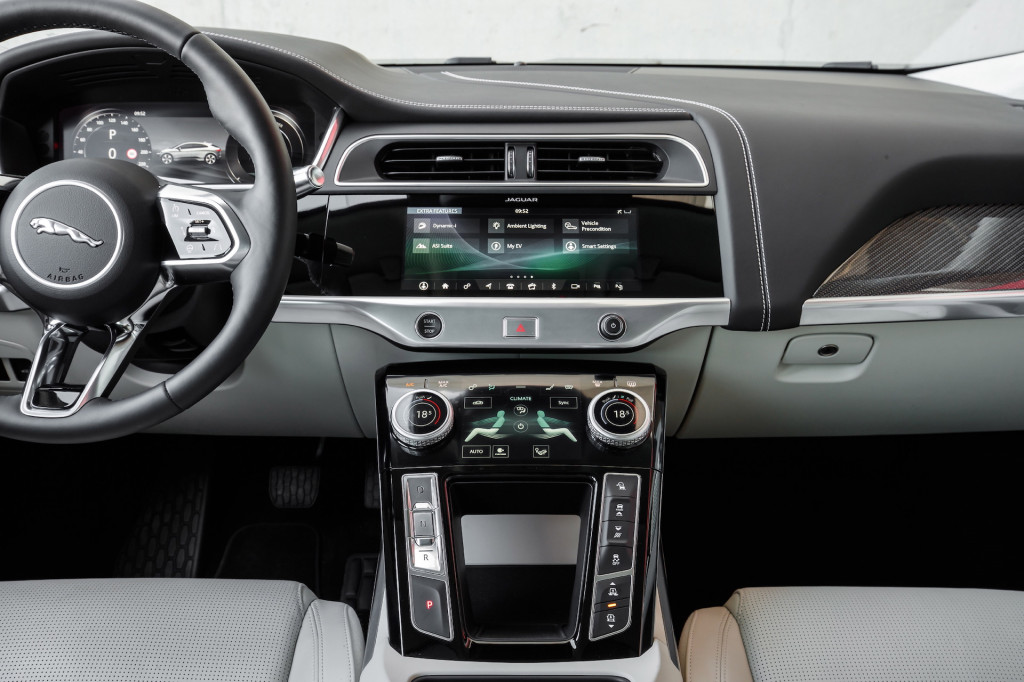It’s not unusual for fuel gauges on gasoline cars to be inaccurate. Often they can hug "Full" so long you might suspect it’s malfunctioning—only to then swing rapidly toward the halfway mark and below.
Usually these idiosyncrasies are no big deal. When the low-fuel light and chime prompt you, you’re almost always within distance of a gas station, where you can fuel up and be back on your way in minutes.
For electric cars, the same is not true. Unfortunately, it’s a version of this that can make road-trip time in some electric vehicles a harrowing experience. The current model where we’ve experienced this kind of range anxiety the most—because of its state-of-charge gauge—is, by far, the Jaguar I-Pace.
The I-Pace is, in many respects, the Tesla alternative that we’ve been waiting for. It’s a fully electric car that’s versatile, the right size for maneuverability and parking ease, with a true luxury-vehicle interior. It performs extraordinarily well and there’s no waiting until later this year, or next year, to take delivery.
Outside of the I-Pace’s often-laggy interface, and the note that its 234-mile range for a huge 90-kwh battery pack isn’t very impressive, the one area of concern—one that multiple members of our editorial team have voiced at various times—has been the I-Pace’s propensity to adjust its driving range downward in sometimes unsettling ways.

2019 Jaguar I-Pace, 3-day test drive - range in very hot weather fell precipitously
The first warning flag was in September, when Green Car Reports contributor (and former Editor) John Voelcker spent a warm fall weekend in a real-world I-Pace drive, putting 230 miles on it. As ambient temperatures hit 90 to more than 104 degrees, he saw estimated range drop by 122 miles in just 65 traffic-flow highway road miles.
Track time
Then in October, we subjected an I-Pace to an extreme use case. One was delivered for our Best Car to Buy finalist drive, with the display showing a 94-percent charge and 239 miles. After 25 laps—about 18 of them truly hot laps—summing to 45.9 miles, we had just 45 percent remaining, which the range meter suggested would be 94 miles. Eighteen very easy-going 50-mph country-road miles later, it seemingly split the difference at 89 miles remaining and 34 percent.

2019 Jaguar I-Pace
“Yeah. We didn’t get a whole lot of help from regen,” our Editorial Director Marty Padgett deadpanned as we surveyed the state of our track cars after hot laps.
With the intensified whoosh we heard under the I-Pace even when we were parked then, that energy from regen likely went toward the task of battery cooling instead. To its credit, out on the track the I-Pace never flashed any warning lights or reduced its power. The I-Pace’s rear motors also allowed us some very fun handling—something close to neutral handling on power, letting us drift through corners if we didn’t first plow the front wheels too much and set off its safety systems.
In fairness, our team, which covers multiple sites including the more traditional-gearhead audience for Motor Authority, also used up most of the Chevrolet Corvette ZR1’s 18.5-gallon tank on just a few more laps than that. And to keep up on other fair points, the ZR1 was a lot easier to fill up quickly along a country-road station on the way back when that fuel gauge dropped.

2019 Jaguar I-Pace at EVgo charger
After driving that I-Pace on country-road loops for a couple of days, charging it to full twice, we left for Atlanta with a 91-percent charge and 197 miles estimated and drove a 141-mile route that ranged from a slow gridlock crawl up to just past 80 mph, briefly. At the end, only 29 miles and 14 percent battery remained. It was 65 degrees outside—nearly perfect conditions for the I-Pace’s LG Chem lithium-ion pouch cells.
The cool-weather highway test
A further test of range came later in the year, when I arranged some driving time in an I-Pace in Portland, Oregon, for a few days. We wanted to get a realistic idea of the I-Pace’s highway range, so I set out with a few basic parameters. The plan: Drive a conservative 68 mph for half of the way. Use the cruise control some but not all of the time. Don’t include a single full-throttle blast. Turn around at a half charge and go 65 mph with more miserly climate settings.
READ MORE: The 2019 Jaguar I-Pace, a city boy, and range anxiety
The route was an out-and-back stretch of Interstate 84 that gains less than 100 feet of elevation from Portland east toward and past The Dalles. We waited for a dry, near-calm night with 1-3 mph winds. The temperature was quite steady—48 degrees at our 7:30 pm start, 44 at our 10:45 pm finish.
Of course, these aren’t the ideal conditions for range. Even in warmer conditions and at conservative speeds, EVs tend to get maybe 10 percent less than their EPA range suggests in real-world highway driving, so it’s reasonable to expect something nearing 20 percent less than the I-Pace’s 234 rated miles even at conservative highway speeds, given the cooler temps and night-time conditions.
With the slight wind and incline in my favor on the return trip—and because I know trip meters themselves can be misleading—I set a turnaround point nearing when the actual indicated battery level was still above 50 percent. I’d use the climate control the whole way out (smart/auto, 72 degrees) but turn it off as much as comfortable on the way back, still using seat heaters. Less energy, same distance—I’d arrive back with some buffer of miles left. So I thought.

Jaguar I-Pace start of road trip
This time I studied and documented (at regular intervals) the way the trip meter behaved in relation to the indicated battery percentage to understand why the I-Pace kept surprising us.
Shortly after setting out on the highway, showing 99 percent battery and an estimated 242 miles remaining (it very briefly displayed 100 percent and 243 miles), the range adjustment started. This downward adjustment of the “miles remaining” makes sense—as a predictive system that was adapting to my driving style and the conditions—and it’s a variation of what would happen in most other EVs.

Jaguar I-Pace road trip
To put a finger on what's different in the I-Pace, it’s the state of charge. Like that inaccurate fuel gauge, it was moving at a rate I hadn’t anticipated, a rate that didn't seem consistent with my current energy use. I turned around at 92 miles, with the state of charge still showing 53 percent. But within some miles after that it became apparent that it was dropping at the same rate if not quicker than earlier in the trip, when I’d kept to higher speeds with the heat on—all while the instant energy readouts were confirming the lower energy use of my slower driving and reduced accessory use. Either that, or the monitors were calling their own bluff.
Range anxiety sets in
The advice I’d told other EV drivers—to just if in doubt follow the state of charge, not the trip meter—had backfired. Over the next 10 miles I lowered the speed to 60 mph. That wasn’t enough to slow the plunge in the state of charge and remaining-range. A following drop to 55 mph finally leveled off the discharge. After 160 total miles, I had 16 percent battery and 24 miles remaining. A low-battery warning went off at 9 percent with 18 miles remaining. I glided into my driveway with 3 percent and 4 miles remaining.
The total trip: 184.1 miles over 3.26 hours, average 56 mph, with a fair amount of range anxiety. Phew.

Jaguar I-Pace end of 184-mi road trip (no recharge)
We reached out to Jaguar Land Rover, and spokesman Nathan Hoyt had some suggestions on what I may have experienced with range, noting that “perhaps most counter-intuitively from an ICE car, steady-state highway driving returns the worst range, whereas steady urban driving can return the best range.”
Hoyt also noted that “further driving in cold temperatures will require some power to be diverted, further adversely affecting range.” With temps just 2-4 degrees lower on the way back, could that account for it? Could driving slower and not running the heat here have actually negatively influenced range because there was less heat for the thermal systems to scavenge? And is that further diverted power represented on the I-Pace's energy-use displays? If the latter was a factor, it would appear not.
I’m an electric-car owner, and I’ve driven nearly every modern EV, short- or long-range. Overlooking the range-meter predictions, it was the plummeting state of charge, combined with the knowledge that at this time there were no CCS (Combo) fast-charging stops I could make (except in the last 15 miles of my trip) that added up to a level of range anxiety I haven’t felt in years.
That’s an anxiety I wouldn’t have felt along that same route with Tesla’s Supercharger network or with CHAdeMO. With the addition of more fast-charging stations, part of that worry about stretching range (or accommodating changes in plans) will be allayed over time.

Jaguar I-Pace in urgent need of electrons
After parking the I-Pace overnight (because I wanted to monitor charging power flow), the next morning the charge had dropped to 1 percent and 1 mile remaining, with no additional use. Green Car Reports’ eMotorWerks JuiceBox Pro charged the I-Pace from 1 percent to full in almost exactly 12.5 hours, all in my 55-degree garage.
According to Jaguar Land Rover, the I-Pace goes into a mode to keep the battery conditioned to a proper temperature range and connected services on the ready. Owners can proactively opt to put the car in hibernation if they're going to keep the car parked for longer periods.
Fix on the way, possibly for the fuel gauge
The I-Pace is the first vehicle from Jaguar Land Rover that can receive over-the-air updates not just for the infotainment system but for battery control systems and core powertrain functions, as well as safety systems and, eventually, perhaps, other vehicle systems. The automaker says that updates have rolled out as often as every few weeks, and that there’s a battery control module update (hardware, not software) that affects some early build production cars.

2019 Jaguar I-Pace S
If you have an I-Pace, it might not even have this issue. As customer cars have been prioritized, not all of its (pre-production) press/demonstration vehicles have received the update.
Short end to long story: We hope to revisit this soon with a production car—and perhaps in future I-Pace drives, we’ll be able to count on its “electric fuel gauge” a little bit more.













